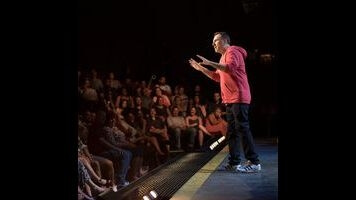In The New York Story, Colin Quinn looks to stereotypes for wisdom—and finds some

Over the past few years, Colin Quinn has organized his restless, garrulous shtick around single—if broad—subjects in a series of one-man shows. After the “all of world history” topic of 2011’s Long Story Short, Quinn pared things down to the U.S. Constitution and its effects in last year’s Unconstitutional. In The New York Story, the stand-up and former Saturday Night Live star has cranked down his cranky comic microscope even finer, crafting his rapid-patter, hour-long special into an examination of his hometown’s history.
Quinn dissects the infamous New York character, variously describing them as rude, opinionated, pushy, loud, fast-talking, sarcastic, wise-assed, abrupt, rude-polite, and above all, politically incorrect. That last one’s not a surprise coming from Quinn, long a purveyor of the “everyone’s too sensitive” school of “tell it like it is” comedy. Fortunately, his curmudgeonliness is more good-natured than some of the more toxic practitioners of the form. Quinn’s grousing is more an affectionately exasperated head tilt than the full-on assaults that other comics launch against “PC culture”—sneering attacks at the likes of feminists, civil rights activists, and basically anyone who thinks people can relate to each other without being bullying, braying assholes.
Quinn’s the quintessential New York guy, which may be why The New York Story—as it was during its successful off-Broadway run—is directed by that other New York guy (and longtime Quinn pal), Jerry Seinfeld. In the fast-moving hour, Quinn is framed by a busy stage made up of a series of typical tableaux from the city’s past and present: an Irish pub, a wharf, a deli/candy counter, a flower cart, a subway turnstile. Quinn’s energetic monologue takes the form of a glibly funny history lesson, where he traces the traits that each successive wave of immigrants (and those of the Lenape tribe who were living there when the Dutch showed up in the 1600s) contributed to what he presents as New York’s true voice. The traits of these various ethnic groups—according to Quinn, the Germans brought the “efficiency over humanity”; the Jews, the complaining skills of “conveying a minor annoyance in apocalyptic terms”—are all subsumed in his signature regular guy “we’re all New Yorkers” shtick.
Quinn brings his stereotypes to life with an entertaining authenticity, especially once his breezy history is couched in personal experiences of coming of age in pre-sanitized New York. From the start of his career, Quinn has presented himself as comedy’s New York ambassador. But, unlike, say Billy Crystal’s cozier NYC of kooky relatives, Quinn offers a lived-in portrait of what it was like as a punk kid stealing from candy stores owned by people of different ethnicities. Or how watching the violence and tearful reconciliation of his Italian friends and their parents was like having a “mini-opera played out right in front of your eyes every day.” He describes how, in the pre-gentrified New York of the ’70s, people used to carry “mugger money” and that the subway put up signs advising people of ways to lessen their risks during “chain-snatching season”; with these details, the comic brings his young adulthood to life in consistently funny fashion.
Quinn’s always been something of a gabbler in performance, his tumbling words often swallowing pauses and whole syllables in his rush to express his restless mind. That served him poorly as SNL’s Weekend Update anchor, but conveyed in this loose but focused format of his own devising, his style is buoyant. The pell-mell rush through the personal material, history lessons, and social commentary in The New York Story again proves that the one-man show is where Quinn functions best. In his role as irascible New York everyman, he talks with the authority of someone who’s actually on the ground, jostling shoulders with the people he’s impersonating. Claiming that New York Russians are the most deadpan, sarcastic people anywhere, Quinn tells of how his attempt to make small talk about a late train elicits a dour, “Eh, mindless chatter will not accelerate.” Reminiscing about the fearless observational skills of the black kids in his high school brings forth the peerless insult, “He lives in the back of the hardware store—comes to school smelling like cut keys.”
In an aside partway through the show, Quinn drops the observation that “there’s a lot less racial tension now,” before joining the wave of mocking laughter coming from the diverse-looking audience at Manhattan’s Schimmel Center For The Arts. The New York Story was performed before the results of this racially charged election showed that America is as divided as it’s ever been, but Quinn’s message isn’t contingent upon votes. For Quinn, the daily cohabitation of centuries of immigrants from all over the world in his rude, loud, obnoxious, but functioning city gives way to the idea that erasing our various cultural heritages—through gentrification or oversensitivity—isn’t the answer. As to what is the answer, Quinn basically offers up himself and his New York neighbors as the messy but inescapable exemplar.
In the end, what Quinn is really railing against is homogenization, a much-revisited swipe at “political correctness” that resurfaces throughout the special. While there’s something patronizing about how tickled Quinn is by cultural differences, he is angriest at attempts to whitewash (if you will) people’s differences in the name of politesse aimed at removing the unique character of the city and its people. Yes, another joke about how unfunny an ethnic joke would be if you took out all the potentially offensive cultural markers is a tired conceit. (“A featureless, colorless, nonsectarian, non-gender-specific person of indeterminate origin walks into a bar…”) It’s an oversimplification (on both sides) of the fact that comedy can be about anything—as long as it’s funny.